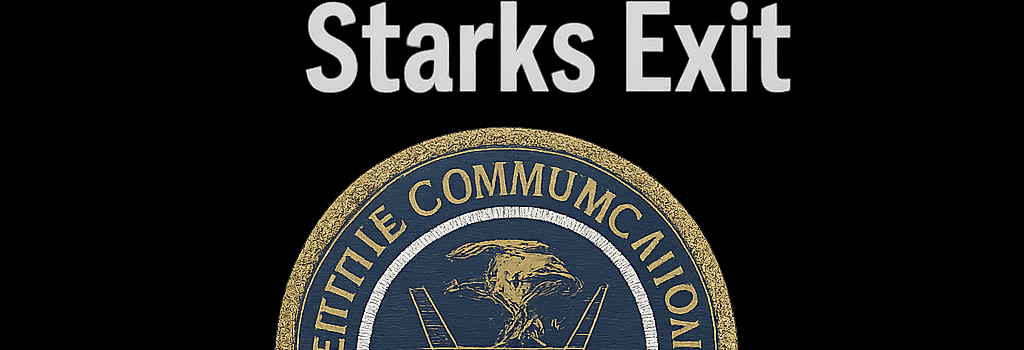FCC Reduced to Two Members as Simington and Starks Exit

The Federal Communications Commission (FCC) is set to enter a period of unprecedented temporary deadlock as Commissioner Nathan Simington and Commissioner Geoffrey Starks officially resign this week, leaving Chairman Brendan Carr (R) and Commissioner Anna Gomez (D) as the sole voting members. This development comes at a pivotal time for telecom policy, with major decisions on spectrum auctions, net neutrality, and broadband expansion looming on the horizon.
Background: FCC Commission Structure and Roles
The FCC is an independent agency composed of five commissioners appointed by the President and confirmed by the Senate, with no more than three commissioners from the same political party. Commissioners typically serve five-year terms and can remain in office until their successors are confirmed, ensuring continuity. The chairman, designated by the President, holds additional administrative authority, sets agenda priorities, and oversees day-to-day operations.
Resignations of Simington and Starks
In March 2025, Democratic Commissioner Geoffrey Starks announced his departure effective June 6, 2025, citing a desire to pursue opportunities in academia and policy research. Today, Republican Commissioner Nathan Simington revealed his simultaneous exit, stating, ‘It has been the greatest honor of my professional life to serve the American people as a Commissioner.’ Both will step down at the end of this week, transitioning the FCC from a 2-2 partisan split to a 1-1 stalemate.
Simington: ‘I am deeply honored to have been entrusted with this responsibility during President Trump’s first term.’
Implications for Policy and Rulemakings
Spectrum Management and 5G Rollouts
With key decisions on mid-band spectrum auctions, including the 3.45-3.55 GHz band and Citizens Broadband Radio Service (CBRS) enhancements, awaiting FCC votes, the departure of two commissioners could delay final rule adoption. The FCC’s technical teams have finalized auction design, specifying 10 MHz blocks with competitive bidding formats. However, without a quorum exceeding two, rulemakings will stall, hindering operators’ ability to plan 5G deployments.
Broadband Expansion and Net Neutrality
Chairman Carr’s ‘Delete, Delete, Delete’ deregulation initiative seeks to roll back Title II classification for broadband under Section 706 of the Communications Act, affecting net neutrality and consumer protection rules. Industry groups such as USTelecom and CTIA have applauded these measures, arguing they reduce regulatory burdens and encourage investment. Conversely, public interest advocates like Public Knowledge warn that removing open internet safeguards could enable throttling or paid prioritization.
Nomination and Confirmation Process for New Commissioners
Following unanimous consent on the nomination of Olivia Trusty, a telecommunications attorney with over a decade of Federal trade policy experience, the Senate Commerce Committee session is scheduled for mid-June. Trusty’s expertise in Section 706 broadband funding programs and supply chain security rules under the Secure and Trusted Communications Networks Act is expected to expedite her confirmation. Once confirmed, Trusty would restore a 2-2 partisan balance, pending a fifth seat.
Expert Perspectives and Market Reactions
Telecom analyst Sarah Rodgers of NTIA Advisory comments, ‘This short-term reduction to two commissioners could freeze critical infrastructure decisions just as the US ramps up its 5G and rural broadband initiatives.’ Morgan Stanley’s sector report estimates a 3-4 month delay in major rulemakings could translate to $1 billion in postponed operator capex. Market observers are also watching the FCC’s upcoming rule on supply chain security, which mandates carriers to remove high-risk equipment by 2027.
Outlook and Future Regulatory Agenda
Despite the temporary impasse, Chairman Carr retains forbearance authority under Section 10 of the Communications Act, allowing selective implementation of deregulatory measures without full commission votes. Carr’s office also announced plans to advance emergency alert IoT integration standards under the Wireless Emergency Alerts (WEA) program, aiming for Phase II rollout in Q4 2025.
The FCC’s next phase will hinge on political negotiations in the Senate and the White House’s prioritization of telecom appointments. Stakeholders across the technology industry will be closely monitoring developments, as regulatory certainty remains crucial for ongoing network investments, AI-enabled telecom services, and IoT device proliferation.